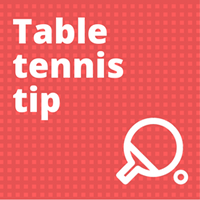If you’re like me, you probably have a serve which you consider your best. A serve which often wins you a cheap point or sets up an easy 3rd ball attack. But when is the best time to use your best serve? Should you use it all the time, only occasionally or somewhere in between? Let’s consider the options…
One approach is to use your best serve a lot. After all, it’s your best serve, so surely it makes sense to use it as often as you can?
This approach can work against a weaker player who hasn’t developed the technique to return the serve. I’ve seen this work in lower divisions of local league table tennis. A player can win a match through the success of one serve alone. Their opponent just doesn’t know what to do and will return the serve the same way every time and lose point after point after point.
But the big risk with over-using your best serve is that your opponent will simply get used to it. You may have success early on in the match, but once your opponent has worked out how to return the serve, it will be far less effective. You will lose a tactical weapon.
The worst case scenario is that your best serve actually becomes a liability. A stronger opponent should quickly be able to work out how to return the serve well, putting you under pressure for the 3rd ball. Rather than winning points using your best serve, you may start losing points.
Another approach is to use your best serve occasionally, maybe at end of a set when the score is close. The logic here is that you are saving your best serve for when it really matters. You avoid the risk of the first approach, because your opponent hasn’t had the chance to get used to the serve.
For example, the score is 10-9, you have set point and it’s your serve. If you use your best serve you should have a very good chance of winning the point and the set. This can be an effective tactic against an opponent you know well (and you know they struggle with the serve).
However, this is a risky tactic against an opponent you haven’t played before. You simply don’t know whether they will find the serve difficult to return. A serve which is difficult for one opponent to return may be very easy for another. So if you use your best serve for the first time at a critical part of a set, it may work, it may not. You simply don’t know.
Even against an opponent you know well it can be risky, because they may well have improved since you last played them and worked out how to return your best serve. If the score is 9-9 and you lose the point, you’re now under real pressure to stay in the set.
A third approach, and the one I advocate, is to try your best serve early in a match and if it’s effective use it at key points during the rest of the match.
The benefits of this approach is that you get to test the serve during a safe period of the first set. If it doesn’t work you’re not in danger of losing the set straight away.
By testing your best serve early, you are gathering intelligence about your opponent. If the serve is effective, then you have a good weapon to use in key points. If the serve doesn’t trouble your opponent, you know you will have to use a different serve in key points.
For example, I’ll often use my best serve in the middle of a set. If the serve is effective and I’m behind (6-4), it can get me back in the set. If tied, (6-6) it can nudge me in the lead. If I’m in the lead (6-4), it can help me build a bigger winning margin. By using the serve earlier in the set, I have tested whether it’s effective and can use it again later in the set, if needed.
And if it’s not effective, no problem. I can simply use other serves. This obviously works best if you have a range of good serves. So if your best serve isn’t effective you have other serves which may cause your opponent difficulty.
This approach generally works for me, although not always. And there are times when I may use one of the first two approaches. There’s no golden rule and you may need to use different approaches for different opponents. The most important thing is to think strategically about how you’re going to use your best serve. Don’t mindlessly over-use or under-use. You best serve should be a strong weapon for you, so use it wisely.
I’d be interested to hear other people’s strategy – when do you use your best serve and why? Please share your experiences and ideas in the comment box below.


